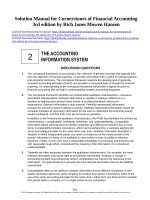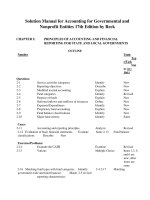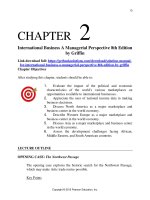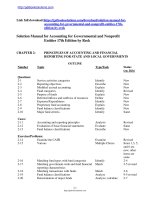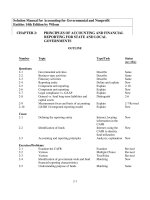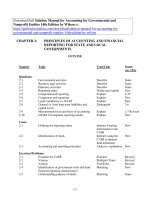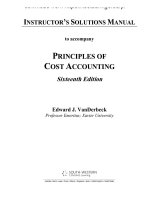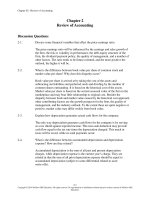Testbank and solution manual for goverment and nonprofit accounting theory and practice 10e freeman (2)
Bạn đang xem bản rút gọn của tài liệu. Xem và tải ngay bản đầy đủ của tài liệu tại đây (423.99 KB, 26 trang )
CHAPTER 2
STATE AND LOCAL GOVERNMENT ACCOUNTING AND
FINANCIAL REPORTING MODEL: THE FOUNDATION
SOLUTIONS MANUAL
ANSWERS TO QUESTIONS
Question 2-1
Governments operate in a different environment than businesses. Governments must comply
with the many finance-related legal and contractual requirements, regulations, restrictions,
and agreements that affect their financial management and accounting. Such compliance must
be demonstrable and be reported on regularly. Governments should also prepare financial
statements in conformity with generally accepted accounting principles (GAAP), which provide
uniform minimum national standards of and guidelines for annual financial reporting to groups
and persons outside the government. Therefore, one fundamental feature of a government’s
accounting system is that it must maintain and provide information that accomplishes multiple
purposes.
Whereas business accounting systems must provide data both for GAAP reporting and for
income tax reporting, governmental accounting systems must provide data both for external
reporting in conformity with GAAP and for controlling and reporting on finance-related legal
compliance matters. This necessitates having different accounting systems for businesses and
governments.
Difficulty: 2
Learning Objective: 1
AACSB: Reflective thinking
Question 2-2
The measurement focus for the three fund categories are:
1.
Proprietary Funds—economic resources (revenues and expenses) measurement focus,
which is the measurement focus used by business enterprises.
2.
Governmental Funds—the current financial resources measurement focus.
3.
Fiduciary Funds—the same measurement focus as proprietary funds—the economic
resources measurement focus.
An economic resources measurement focus results in accounting for all assets—both current
and noncurrent—and all liabilities—both current and long-term. A current financial resources
measurement focus results in accounting for financial assets and related liabilities. Noncurrent
© 2013 Pearson Education, Inc. publishing as Prentice Hall
10
assets and long-term liabilities are not reported under a current financial resources measurement
focus.
Difficulty: 1
Learning Objective: 2, 3
AACSB: Reflective thinking
Question 2-3
For governmental funds:
1.
Revenues must be (1) "available"—collectible within the period or soon enough
thereafter to be used to pay for the expenditure liabilities incurred during the period, as
well as levied or earned—and (2) measurable to be recognized.
2.
Expenditures are financial assets expended during a period for current operations,
capital outlay, and debt service including (a) long-term debt principal retirement and (b)
interest on both short-term and long-term indebtedness.
For proprietary funds:
1.
Revenues are recognized when earned and measurable.
criterion for revenues recognized in proprietary funds.
2.
Expenses are costs consumed or expired during a period.
There is no “availability”
Difficulty: 1
Learning Objective: 2, 3, 5
AACSB: Reflective thinking
Question 2-4
General capital assets are not considered appropriable resources and unmatured general longterm liabilities are not current liabilities. Hence, these assets and liabilities would not
appropriately be accounted for within a municipality's governmental (expendable) funds, which
are net current financial resource entities. Further, general capital assets are considered to belong
to the government as a whole, not to a particular department or enterprise; and unmatured general
long-term liabilities are likewise considered obligations of the government, not of a specific fund.
Thus, neither fits conveniently into the existing fund structure of state and local governmental
accounting and both are accounted for through the General Capital Assets and General LongTerm Liabilities nonfund accounts. They are reported only in the government-wide financial
statements.
Difficulty: 2
Learning Objective: 4
AACSB: Reflective thinking
© 2013 Pearson Education, Inc. publishing as Prentice Hall
11
Question 2-5
Capital assets and long-term liabilities are accounted for in:
General Capital Assets and General Long-Term Liabilities accounts
Enterprise Funds
Internal Service Funds
Trust Funds (some)
General capital assets and general long-term liabilities are accounted for in the General Capital
Assets and General Long Term Liabilities accounts. They are related to general government
(governmental) activities.
Difficulty: 1
Learning Objective: 4
AACSB: Reflective thinking
Question 2-6
A Special Revenue Fund should be used to account for and report the proceeds of specific
revenue sources that are restricted or committed to expenditure for specified purposes other than
debt service or capital projects.
A Capital Projects Fund should be used to account for and report financial resources that are
restricted, committed, or assigned to expenditure for capital outlays, including the acquisition or
construction of capital facilities and other capital assets.
A Debt Service Fund should be used to account for and report financial resources that are
restricted, committed, or assigned to expenditure for principal and interest on general long-term
liabilities.
Difficulty: 1
Learning Objective: 6
AACSB: Reflective thinking
Question 2-7
Proprietary funds include Enterprise Funds and Internal Service Funds. Proprietary fund
financial statements include a balance sheet (statement of net assets), statement of revenues,
expenses, and changes in net assets, and statement of cash flows.
Difficulty: 1
Learning Objective: 6, 7
AACSB: Reflective thinking
© 2013 Pearson Education, Inc. publishing as Prentice Hall
12
Question 2-8
Governmental funds include the General Fund, Special Revenue Funds, Capital Projects Funds,
Debt Service Funds, and Permanent Funds. Governmental fund financial statements include a
balance sheet (or statement of net assets), statement of revenues, expenditures, and changes in
fund balance-GAAP basis, and statement of revenues, expenditures, and changes in fund
balance-budget and actual (on the budgetary basis of accounting).
Difficulty: 1
Learning Objective: 6, 7
AACSB: Reflective thinking
Question 2-9
Fiduciary funds include Private-Purpose Trust Funds, Investment Trust Funds, Pension Trust
Funds, and Agency Funds. Trust fund financial statements include a statement of net assets and a
statement of changes in net assets. Agency Fund financial statements include a statement of net
assets and a statement of changes in agency fund assets and liabilities (required in a
comprehensive annual financial report but not in the basic financial statements).
Difficulty: 1
Learning Objective: 6, 7
AACSB: Reflective thinking
Question 2-10
One only: General Fund and General Capital Assets and General Long-Term Liabilities accounts
One, none, or many - - all other fund types:
Special Revenue Funds
Capital Projects Funds
Debt Service Funds
Permanent Funds
Internal Service Funds
Enterprise Funds
Private-Purpose Trust Funds
Investment Trust Funds
Pension Trust Funds
Agency Funds
Difficulty: 1
Learning Objective: 2, 6
AACSB: Reflective thinking
Question 2-11
Interfund loans are amounts provided by one fund to another with a requirement for and
expectation of repayment. Interfund loans are the only type of interfund transaction that initially
© 2013 Pearson Education, Inc. publishing as Prentice Hall
13
affects only balance sheet accounts. Because interfund loans are expected to be repaid, a loan is
reported as a receivable (asset) in the lending fund and as a payable (liability) in the debtor fund.
Interfund transfers are flows of assets (such as cash or goods) from one fund to another
without equivalent flows of assets or services in return and without a requirement for
repayment.
In governmental funds, transfers should be reported as other [nonexpenditure] financing
uses in the funds making transfers and as other [nonrevenue] financing sources in the
funds receiving transfers.
In proprietary funds, transfers should be reported as the last item before the subtotal for
changes in net assets.
Difficulty: 2
Learning Objective: 7
AACSB: Reflective thinking
Question 2-12
The Basic Financial Statements, which must be accompanied by Management’s Discussion and
Analysis and certain other required supplementary information, include the government-wide
financial statements (Statement of Net Assets and Statement of Activities), the three sets of fund
financial statements (governmental fund financial statements, proprietary fund financial
statements, and fiduciary fund financial statements), and the related notes. The Comprehensive
Annual Financial Report (CAFR) of a governmental unit includes the basic financial statements,
but is much more extensive. A CAFR contains:
1.
2.
3.
4.
5.
6.
7.
Introductory materials, e.g., letter(s) of transmittal.
Management's Discussion and Analysis,
Basic Financial Statements and notes,
Combining financial statements (for nonmajor governmental funds, nonmajor
Enterprise Funds, Internal Service Funds, Trust Funds, and Agency Funds—if there are
two or more funds in these categories. These are a minimum. Other combining
statements may be presented.)
Individual fund financial statements and schedules (where appropriate),
Narrative explanations (notes for combining or individual fund financial statements),
and
Statistical section.
Items 2 through 6, including the auditor’s report, are called the financial section of a CAFR.
Difficulty: 2
Learning Objective: 7
AACSB: Reflective thinking
© 2013 Pearson Education, Inc. publishing as Prentice Hall
14
Question 2-13
Government-wide financial statements are prepared using the same measurement and basis of
accounting that is used for proprietary funds—the economic resources measurement focus and
the accrual basis of accounting.
Difficulty: 1
Learning Objective: 3
AACSB: Reflective thinking
Question 2-14
The accounting equation for a governmental fund is:
(Financial Assets + Deferred Outflows) – (Related Liabilities + Deferred Inflows) =
Fund Balance
Difficulty: 1
Learning Objective: 2
AACSB: Reflective thinking
Question 2-15
The accounting equation for a proprietary fund is:
Assets + Deferred Outflows – Liabilities - Deferred Inflows = Net Position
Difficulty: 1
Learning Objective: 2
AACSB: Reflective thinking
Question 2-16
Deferred outflows and deferred inflows result from delaying operating statement recognition of
certain changes in the net amount of assets less liabilities. The GASB requires these changes to
be classified as deferred outflows instead of assets (or as deferred inflows instead of liabilities)
when the GASB views the change as related to future periods.
Deferred outflows are reported similarly to assets, and changes in deferred outflows affect the
operating statement in essentially the same way as changes in assets. Likewise, deferred inflows
are reported similarly to liabilities, and changes in deferred inflows affect the operating statement
in essentially the same manner as changes in liabilities.
© 2013 Pearson Education, Inc. publishing as Prentice Hall
15
Difficulty: 2
Learning Objective: 2
AACSB: Reflective thinking
Question 2-17
The General Fund is always a major fund. In addition, any other governmental fund or
Enterprise Fund that meets both of the following "size" criteria must be reported as a major fund.
The quantitative major fund criteria are:
1.
Total assets, liabilities, revenues, or expenditures/expenses (excluding extraordinary
items) of that individual governmental fund or Enterprise Fund are at least 10% of the
corresponding total (assets, liabilities, revenues, or expenditures/expenses) for all funds
of that category or type (i.e., total governmental funds or total Enterprise Funds)
2.
The same element that met the 10% criterion in (a) is at least 5% of the corresponding
element total for all governmental funds and Enterprise Funds combined.
A governmental fund or Enterprise Fund that does not meet the size criteria may still be treated
as a major fund if the government deems it of sufficient importance to statement users. Thus, a
government must identify as a major fund each governmental fund or Enterprise Fund for which
statement users are likely to need individual fund information.
Difficulty: 2
Learning Objective: 2
AACSB: Reflective thinking
© 2013 Pearson Education, Inc. publishing as Prentice Hall
16
SOLUTIONS TO EXERCISES
Exercise 2-1
1.
2.
3.
4.
5.
6.
7.
8.
9.
10.
a
b
d
a
b
d
c
d
a
d
Difficulty: 1
Learning Objective: 2, 3, 4
AACSB: Reflective thinking
Exercise 2-2
1.
2.
3.
4.
5.
6.
7.
8.
9.
10.
b
c
a
d
b
c
c
c
a
c
Difficulty: 1
Learning Objective: 2, 3, 4
AACSB: Reflective thinking
Exercise 2-3
1.
2.
3.
4.
5.
6.
7.
8.
9.
10.
Special Revenue Fund
Capital Projects Fund
Enterprise Fund
General Fund
General Capital Assets and General Long-Term Liabilities accounts
General Capital Assets and General Long-Term Liabilities accounts
General Capital Assets and General Long-Term Liabilities accounts
Debt Service Fund
Enterprise Fund
Internal Service Fund
© 2013 Pearson Education, Inc. publishing as Prentice Hall
17
Difficulty: 1
Learning Objective: 2, 4, 6
AACSB: Reflective thinking
Exercise 2-4
a.
b.
c.
d.
e.
f.
Special Revenue
Debt Service
Capital Projects
Special Revenue
Internal Service
Enterprise, if criteria met; otherwise Special Revenue if the revenues are restricted or
committed and General Fund if not
g. Agency
h. General
i. Enterprise
j. Capital Projects
k. Debt Service
l. Permanent
m. Capital Projects
n. Pension Trust
Difficulty: 1
Learning Objective: 5
AACSB: Reflective thinking
Exercise 2-5
a, b, c, and d
Difficulty: 1
Learning Objective: 3
AACSB: Reflective thinking
© 2013 Pearson Education, Inc. publishing as Prentice Hall
18
Exercise 2-6
Name of Government
Governmental Fund
Statement of Revenues, Expenditures, and Changes in Fund Balances
Time Period Report Covers
Revenues (by source)
c
Expenditures (by function)
d, f, g, h, i
Excess of Revenues Over (Under) Expenditures
Other Financing Sources (Uses)
a, (b)
Special and Extraordinary Items* e, k
Net Change in Fund Balance
Fund Balance (Total), Beginning
Fund Balance (Total), Ending
*The amounts reported for special items and extraordinary items would be proceeds received or
expenditures incurred for those items, not gains and losses.
Note: Depreciation expense (j) is not recorded in this statement.
Difficulty: 2
Learning Objective: 7
AACSB: Analytical Skills
Exercise 2-7
Name of Government
Proprietary Fund
Statement of Revenues, Expenses, and Changes in Net Assets
Time Period Report Covers
Operating revenues (by source)
c
Total operating revenues
Operating expenses (detailed)
d, i
Total operating expenses
Operating income
Nonoperating revenues and
expenses (detailed)
h, k
Income before capital contributions, special and extraordinary items, and transfers
Capital contributions
Special and extraordinary
items (detailed)
e, j
Transfers
b
Increase (decrease) in net assets
Net assets—beginning of period
© 2013 Pearson Education, Inc. publishing as Prentice Hall
19
Net assets—end of period
Note: Proceeds from issuing bonds (a), Expenditures for purchases of equipment (f), and
Expenditures for principal retirement of long-term liabilities (g) are not reported in this
statement.
Difficulty: 2
Learning Objective: 7
AACSB: Analytical Skills
Exercise 2-8
Name of Government
Governmental Fund
Balance Sheet
Fiscal Year-End
Assets
a, d, g
Liabilities and fund balance
Liabilities
Fund balance
Total liabilities and fund balance
j
c, i
Note: Unrestricted net assets (b), Land (e), Bonds payable (f), Current portion of bonds payable
(h), and Buildings and equipment (k) are not reported in this statement.
Difficulty: 2
Learning Objective: 7
AACSB: Analytical Skills
© 2013 Pearson Education, Inc. publishing as Prentice Hall
20
Exercise 2-9
Name of Government
Proprietary Fund
Balance Sheet
Fiscal Year-End
Assets
Current Assets:
Noncurrent Assets:
Capital Assets
Total Assets
a, d, g
e, k
Liabilities
Current liabilities
Noncurrent liabilities
Total liabilities
h, j
f
Net Assets
b
Total liabilities and net assets
Note: Nonspendable fund balance (c) and Unassigned fund balance (i) are not reported in this
statement.
Difficulty: 2
Learning Objective: 7
AACSB: Analytical Skills
© 2013 Pearson Education, Inc. publishing as Prentice Hall
21
Exercise 2-10
(1) Proprietary fund
ILLUSTRATION 2–6 Analysis of Transactions for Business-Type Activities
Proprietary Funds
a.
b.
c1.
c2.
d.
e.
f.
g.
h.
i.
j.
k.
CA
($5,100)
3,000
2,000
+
NCA
–
CL
$200
–
LTL
=
NA
($5,300)
3,000
2,000
150
(2,150)
(2,200)
200
1,000
(100)
(800)
(900)
(150)
(50)
$200
$1,000
(100)
(800)
$900
(280)
(60)
35
(280)
(25)
*Calculations for:
c2. Interest accrual at year-end, $2,000 x .10 x 9/12 = $150
d. Liability reduction equals principal of $2000 plus accrued interest payable of $150.
k. Capital asset carrying value at disposal equals $60 (Cost of $900 less accumulated
depreciation after three years of $840). Proprietary fund loss on sale of the capital asset is
$35 (proceeds) less $60 (carrying value) or $25.
(2) Governmental fund and nonfund accounts
ILLUSTRATION 2–7 Analysis of Transactions for General Government Activities
General Capital Assets and General
Long-Term Liabilities Accounts
Governmental Funds
a.
b.
c1
c2.
d.
e.
f.
g.
h.
i.
j.
k.
FA
($5,100)
3,000
2,000
(2,200)
200
1,000
(100)
(800)
(900)
35
–
RL
$200
2,000
150
(2,150)
=
FB
($5,300)
3,000
(150)
(50)
200
1,000
(100)
(800)
(900)
35
GCA
–
GLTL
=
NA
$1,000
($1,000)
(800)
800
900
(280)
(60)
$900
(280)
(60)
© 2013 Pearson Education, Inc. publishing as Prentice Hall
22
Exercise 2-10 (Continued)
Legend
CA
CL
LTL
NA
NCA
Proprietary Funds
Current Assets
Current Liabilities
Long-Term Liabilities
Net Asset
Noncurrent Assets (including capital assets)
Governmental Fund;
General Capital Assets and
General Long-Term Liabilities Accounts
FA Financial Assets
RL Related Liabilities
FB Fund Balance
GCA General Capital Assets
GLTL General Long-Term Liabilities
NA Net Assets
Difficulty: 3
Learning Objective: 4
AACSB: Analytical Skills
© 2013 Pearson Education, Inc. publishing as Prentice Hall
23
SOLUTIONS TO PROBLEMS
Problem 2-1 (a)
Analysis of Transactions for General Government Activities
General Capital Assets and General
Long-Term Liabilities Accounts
Governmental Funds
E.
1.
2.
3.
4.
4*
5.
6.
7.
8.
Fund
GF
GF
CPF
CPF
GF
GF
GF
DSF
GF
FA
8,000†
–
RL
=
$75,000
$9,000,000
(5,000,000)
60,000
1,200**
(8,000,000)
(11,000,000)
1,500
FB
8,000†
($75,000)
9,000,000
(5,000,000)
(60,000)
(1,200)
(8,000,000)
(11,000,000)
1,500
GCA
–
GLTL
=
NA
$9,000,000
($9,000,000)
5,000,000
60,000
3,000,000
(10,000,000)
(3,000,000)
10,000,000
(1,000)
$5,000,000
60,000
(1,000)
†The
text (page 64) shows parenthesis around this number. It is an increase, therefore should not be in parenthesis.
*Year-end entry.
**($60,000 x .06 x 4/12)
Legend
FA
Financial Assets
GF
General Fund
RL
Related Liabilities
CPF
Capital Projects Fund
FB
Fund Balance
DSF
Debt Service Fund
GCA
General Capital Assets
GLTL General Long-Term Liabilities
NA
Net Assets
ILLUSTRATION 2–6 Analysis of Transactions for Business-Type Activities
Airport Enterprise Fund
5.
CA
$8,000,000
+
NCA
–
CL
–
LTL
=
NA
$8,000,000
© 2013 Pearson Education, Inc. publishing as Prentice Hall
24
Problem 2-1 (b)
1.
2.
3.
4.
5.
6.
7.
8.
Expenditures of $75,000 reported in General Fund.
Other Financing Sources—Bond Proceeds of $9,000,000 reported in Capital Projects Fund.
Expenditures of $5,000,000 reported in Capital Projects Fund.
Expenditures of $60,000 reported in General Fund.
At year-end, expenditures of $1,200 interest reported in General Fund.
Other Financing Uses (Transfer to Other Fund) of $8,000,000 reported in General Fund.
Transfers from Other Fund of $8,000,000 reported in Airport Enterprise Fund.
No operating statements are prepared for GCA-GLTL accounts.
Expenditures of $11,000,000 reported in Debt Service Fund.
Other Financing Sources of $1,500 reported in General Fund.
Enterprise Fund Legend
CA
CL
LTL
NA
NCA
Current Assets
Current Liabilities
Long-Term Liabilities
Net Assets
Noncurrent Assets (including capital assets)
Difficulty: 2
Learning Objective: 4
AACSB: Analytical Skills
© 2013 Pearson Education, Inc. publishing as Prentice Hall
25
Problem 2-2 (a)
Governmental Funds
Fund
Financial Assets
1.
GF
($500,000)
2.
SRF
(38,000)
4a.
GF
50,000
4b.*
GF
5.
CPF
15,000,000
6.
CPF
(185,000)
7.
CPF
(14,715,000)
8a.**
CPF
(100,000)
8b.
DSF
100,000
9a.
GF
(1,500,000)
9b.
DSF
1,500,000
10.***
DSF
(1,200,000)
11.****
GF
(53,750)
13.
GF
(100,000)
14.
GF
4,000
15.
DSF
(110,000)
* $50,000 x .10 x 6/12
** $15,000,000 - $185,000 - $14,715,000
*** $15,000,000 x .08 x 1
**** $50,000 x .10 x 3/12 = $1,250
Related Liabilities
=
50,000
2,500
Fund Balance
($500,000)
(38,000)
(2,500)
15,000,000
(185,000)
(14,715,000)
(100,000)
100,000
(1,500,000)
1,500,000
(1,200,000)
(1,250)
(110,000)
4,000
(110,000)
(52,500)
10,000
General Capital Assets (GCA) and General Long-Term Liabilities (GLTL) accounts
GCA
GLTL
=
Net Assets
2.
$38,000
$38,000
5.
15,000,000
(15,000,000)
6.
185,000
185,000
7.
14,715,000
14,715,000
14.*
(9,000)
(9,000)
15.
(100,000)
100,000
* $15,000 less accumulated depreciation of ($15,000 - $7,000) x 3/4
Proprietary Funds
Current
Fund Assets (CA)
3a.
EF
$5,000,000
3b.* EF
12.
EF
1,000,000
13.
EF
110,000
* $5,000,000 x .06 x 3/12
+
NonCA
-
Current
Liabilities
-
Long-term
Liabilities
$5,000,000
$75,000
© 2013 Pearson Education, Inc. publishing as Prentice Hall
26
=
Net Assets
($75,000)
1,000,000
110,000
Problem 2-2 (b)
REPORTING in the Statement of Revenues, Expenditures, and Changes in Fund Balance of the:
1.
2.
4b.
5.
6.
7.
8a.
8b.
9a.
9b.
10.
11.
13.
14.
15.
GF—Expenditures, $500,000
SRF—Expenditures, $38,000
GF—Expenditures, $2,500
CPF—Other financing sources—Bonds $15,000,000
CPF—Expenditures, $185,000
CPF—Expenditures, $14,715,000
CPF—Other financing uses—Transfer to other funds, $100,000
DSF—Other financing sources—Transfer from other funds, $100,000
GF—Other financing uses—Transfer to other funds, $1,500,000
DSF—Other financing sources—Transfer from other funds, $1,500,000
DSF—Expenditures, $1,200,000
GF—Expenditures, $1,250
GF—Expenditures, $110,000
GF—Other financing sources of $4,000
DSF—Expenditures, $110,000
REPORTING in the Statement of Revenues, Expenses, and Changes in Net Assets
3b.
12.
13.
Nonoperating expense (Interest expense), $75,000
Operating revenues, $1,000,000
Operating revenues, $110,000
Difficulty: 3
Learning Objective: 4, 7
AACSB: Analytical Skills
© 2013 Pearson Education, Inc. publishing as Prentice Hall
27
Problem 2-3 (1)
Governmental Funds
1.
2.
3a.
3b.
4.
Fund
CPF
CPF
GF
DSF
GF
Financial Assets
$4,000,000
(2,200,000)
(120,000)
120,000
(315,000)
-
Related Liabilities
=
600,000
Fund Balance
$4,000,000
(2,800,000)
(120,000)
120,000
(315,000)
General Capital Assets (GCA) and General Long-Term Liabilities (GLTL) accounts
GCA
GLTL
=
Net Assets
1.
$4,000,000
($4,000,000)
2.
$2,800,000
2,800,000
4.
(300,000)
300,000
Proprietary Funds
Current
Fund Assets (CA)
5a.
EF
$14,000,000
5b.* EF
* $14,000,000 x .06 x 3/12
+
NonCA
-
Current
Liabilities
-
Long-term
Liabilities =
$14,000,000
$210,000
Net Assets
($210,000)
Problem 2-3 (2)
REPORTING in the Statement of Revenues, Expenditures, and Changes in Fund Balance of the:
1.
2.
3a.
3b.
4.
CPF—Other financing sources—Bonds , $4,000,000
CPF—Expenditures, $2,800,000
GF—Other financing uses—Transfer to other funds, $120,000
DSF—Other financing sources—Transfer from other funds, $120,000
GF—Expenditures, $315,000
REPORTING in the Statement of Revenues, Expenses, and Changes in Net Assets
5b.
Nonoperating expense (Interest expense), $210,000
Difficulty: 2
Learning Objective: 4, 7
AACSB: Analytical Skills
© 2013 Pearson Education, Inc. publishing as Prentice Hall
28
Problem 2-4 (a)
Governmental Funds
Fund
Financial Assets
- Related Liabilities =
Fund Balance
1.*
GF
($3,000,000)
($18,000)
($2,982,000)
2. **
CPF
10,000,000
10,000,0000
3.
No entry required.
4.
CPF
(5,000,000)
346,500
(5,346,500)
5a.***
GF
(1,400,000)
(1,400,000)
5b.
DSF
1,400,000
1,400,000
5c.**** DSF
(1,400,000)
(1,400,000)
6.
GF
(500,000)
(500,000)
7.
GF
1,500,000
1,500,000
8.
GF
15,000
15,000
*
Related Liabilities: $50,000 - $32,000 = $18,000 decrease during year
** Though not required by the problem, some students may analyze the first (mid-year)
semiannual interest payment on these bonds. This payment decrease DSF financial assets
and fund balance by ($10,000,000 x .08 x .5, or $400,000). Interest expenditures of
$400,000 would be reported in the DSF operating statement.
*** Interest Paid: $10,000,000 x .08 x 1/2 = $400,000
**** Principal ($1,000,000) + Interest ($400,000)
General Capital Assets (GCA) and General Long-Term Liabilities (GLTL) accounts
GCA
GLTL
=
Net Assets
2.
$10,000,000
($10,000,000)
4.
$5,346,500
5,346,500
5c.
(1,000,000)
1,000,000
6.
7,000,000
(7,000,000)
7. *
(500,000)
(500,000)
8.
(20,000)
(20,000)
The problem does not state explicitly that the land sold is a general capital asset. If not, it
likely would be land of an enterprise activity in which case neither the GF nor the GCA are
affected. As an EF transaction, the analysis would be CA (+ $1,500,000), NCA (-$500,000),
and NA (+$1,000,000). The $1,000,000 increase in net assets would be reported in the EF
operating statement as a nonoperating gain unless determined to qualify as a special item.
© 2013 Pearson Education, Inc. publishing as Prentice Hall
29
Problem 2-4 (b)
REPORTING in the Statement of Revenues, Expenditures, and Changes in Fund Balance of the:
1.
GF—Expenditures, $2,982,000
2.
CPF—Other financing sources—Bonds, $10,000,000
3.
No effect.
4.
CPF—Expenditures, $5,346,500
5a.
GF—Other financing uses—Transfer to other funds, $1,400,000
5b.
DSF—Other financing sources—Transfer from other funds, $1,400,000
5c.
DSF—Expenditures, $1,400,000
6.
GF—Expenditures, $500,000
7.
GF—Other financing sources of $1,500,000 unless it qualifies as a special item
8.
GF—Other financing sources of $15,000
Difficulty: 2
Learning Objective: 4, 7
AACSB: Analytical Skills
© 2013 Pearson Education, Inc. publishing as Prentice Hall
30
Problem 2-5 (a)
Though the statement presented, with minor modification, would be appropriate to present the
sources and uses of the financial resources of a governmental (expendable) fund such as the
General Fund, the operation of this bus line service is a long-term “business-type” undertaking.
All assets, liabilities, and equity associated with the bus line should be accounted for through an
Enterprise Fund. All expenses (not expenditures)–including depreciation, inventories consumed,
and interest–should be reported in order for the operating results of such an activity to be
assessed validly.
While the General Fund-based operating statement shown reports a “net profit,” an accrual basis
statement would reflect different information once depreciation expense, inventory consumption
and interest expense are included.
Problem 2-5 (b)
Mobiline County Enterprise Fund Bus Line
Statement of Revenues and Expenses
For the Nine Month Period Ending October 31, 20X3
Operating Revenues:
Passenger fares—routine route service ...........................
Special charter fees (1) ...................................................
Operating Expenses:
Salaries (superintendent, drivers, mechanics).................
Depreciation Buses (2) .................................................................. $21,000
Building (3)..............................................................
6,000
Shop equipment (4) .................................................
1,125
Fuel and lubrication ........................................................
Tires and parts (5) ...........................................................
Contracted repairs and maintenance ...............................
Miscellaneous .................................................................
$77,000
4,000
$81,000
52,000
28,125
12,000
13,000
8,000
1,000
114,125
Operating Loss .......................................................................
(33,125)
Nonoperating Revenues and Expenses:
Interest expense (6) .........................................................
13,500
Decrease in Net Assets ...........................................................
Net assets, February 1, 20X3…………………………… .....
Net assets, October 31, 20X3…………………………... ......
(46,625)
$(46,625)
© 2013 Pearson Education, Inc. publishing as Prentice Hall
31
Computations:
(1) $3,000 collected + $1,000 accrued = $4,000
(2) 3/4($140,000/5) = $21,000
(3) 3/4($80,000/10) = $6,000
(4) 3/4($15,000/10) = $1,125
(5) $15,000 acquired 2/1/X3 + $1,000 purchased - $3,000 on hand = $13,000
(6) .06(10 x $30,000) 3/4 = $13,500
Difficulty: 3
Learning Objective: 3, 4, 7
AACSB: Reflective thinking
© 2013 Pearson Education, Inc. publishing as Prentice Hall
32
Problem 2-6 (a)
Cash Basis
Dr.
Cr.
1-1 Accounts Receivable
Revenues
Modified Accrual Basis
Dr.
Cr.
4,000
4,000
1-3 Expenditures
Inventory of Supplies
Accounts Payable
500
1-5 Expenditures
Truck
Accounts Payable
30,000
1-11Cash
2,000
Accounts Receivable
Revenues
2,000
500
500
500
30,000
30,000
30,000
2,000
2,000
2,000
2,000
1-15 Expenditures
Expenses
Wages Payable
1-17 Expenditures
Accounts Payable
Cash
Accrual Basis
Dr.
Cr.
4,000
4,000
3,000
3,000
3,000
3,000
500
500
500
1-21 Expenditures
Wages Payable
Cash
3,000
2-3 Expenditures
Accounts Payable
Cash
30,000
500
500
3,000
3,000
3,000
3,000
30,000
30,000
500
3,000
30,000
30,000
30,000
2-5 Expenses
Inventory of
Supplies
200
2-6 Depreciation Expense
Accumulated
Depreciation
500
200
500
Problem 2-6 (b)
The modified accrual and accrual bases are similar in that accruable revenue is recognized prior
to cash receipt. They are also similar in that liabilities are recognized when incurred. However,
the accrual basis measures expenses (costs expired) while the modified accrual basis measures
expenditures (net financial assets expended for current operations, capital outlay, long-term debt
principal retirement, and interest).
© 2013 Pearson Education, Inc. publishing as Prentice Hall
33
Difficulty: 2
Learning Objective: 3, 4
AACSB: Reflective thinking
SOLUTION TO CASES
Case 2-1
1.
2.
3.
4.
5.
6.
7.
8.
9.
10.
11.
12.
13.
Special Revenue Fund
Internal Service Fund
Debt Service Fund
Enterprise Fund
Capital Projects Fund
Capital Projects Fund
Capital Projects Fund
Internal Service Fund
Agency Fund
Internal Service Fund
Enterprise Fund
Pension Trust Fund
Special Revenue Fund
Students discussion and questions may demonstrate that they have made good progress on
mastering the fund structure even when an answer is incorrect. For instance, a student who notes
that item 10 does not explicitly state the charges are intended to reimburse the costs of services
provided might give a response other than an Internal Service Fund. Raising this point reflects
that the student has learned the Internal Service Fund definition. However, the fact that it is
named a revolving fund suggests the “capital maintenance” notion, which is a primary
consequence of cost-reimbursement based charges.
Difficulty: 2
Learning Objective: 7
AACSB: Reflective thinking
© 2013 Pearson Education, Inc. publishing as Prentice Hall
34
